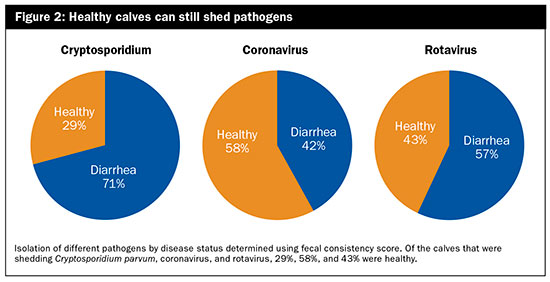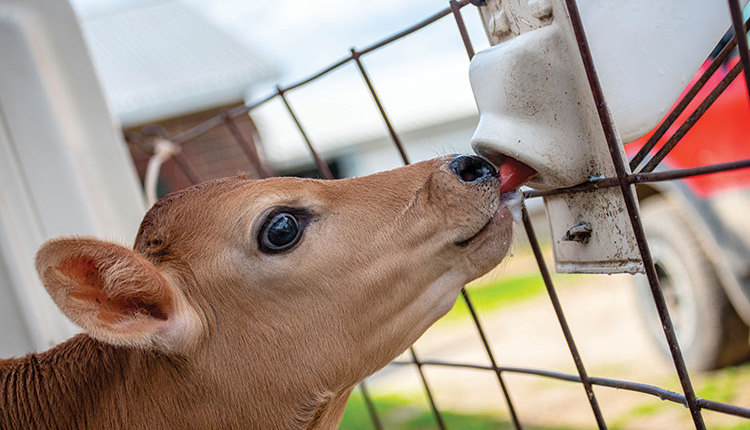The author is an assistant professor at the University of Guelph.
Diarrhea remains a common challenge on dairy farms and calf raising operations around the world. This challenge is also costly.
At the University of Guelph, we recently completed a study that evaluated 2,600 animals at a calf raising facility. The calves had their feces scored for consistency twice daily, at morning and evening feedings, with diarrhea being defined as feces that had a runny or watery consistency. Calves were frequently weighed and all disease treatments were recorded.
What we found was not surprising, but it is a good reminder of the challenges associated with diarrhea. Specifically, we found that calves with diarrhea for one day or more:
• Gained 0.24 pounds (0.11 kilograms) per day less and the losses worsened when calves had a longer duration with diarrhea (see Figure 1).

• Had a greater risk of developing respiratory disease (69% with diarrhea versus 56% without diarrhea) and dying (8% with diarrhea versus 4% without diarrhea).
Another recent study conducted by Angel Abeulo at Michigan State University found pronounced lifelong impacts to having diarrhea treatment in the preweaned period. Specifically, they found that calves treated for diarrhea preweaning had a 716.5 pound (325 kilograms) reduction in first lactation milk production. Based on this and previous research, it is clear that diarrhea has tremendous short- and long-term impacts.
How does diarrhea occur?
When thinking about diarrhea prevention, it is important to understand why it occurs. Previously, it was thought that simple exposures to pathogens lead to diarrhea, but that is not the case, as healthy calves can still be shedding different pathogens. Specifically, as shown in
Figure 2, a recent study highlights both calves with diarrhea and healthy calves can shed rotavirus, coronavirus, and Cryptosporidium parvum, all common diarrhea-causing pathogens.

So, if it is not just exposure to pathogens, why does diarrhea happen? It comes down to the complex environment of the gastrointestinal tract, especially the bacterial community. When looking at the bacteria in the gut, it has been shown in several studies that calves with a more diverse bacterial community and higher levels of certain “good” bacteria, such as Faealibacterium and Ruminococcaceae, are much less likely to develop diarrhea.
It starts with colostrum
To prevent diarrhea, we need to think about how to set the gut up for success by having the right bacteria present. This starts with colostrum. It is likely this sounds like a broken record; however, making sure that the first feeding of colostrum is of high quality (greater than 50 grams per liter of IgG or greater than 22% on a Brix refractometer), fed at an adequate volume (at least 3 liters of colostrum) and quickly following calving (less than three hours of life) is critical to achieving high levels of IgG in the blood stream and ensuring successful transfer of passive immunity. It is important to note that it is not just the IgG that is important; there are many different bioactive components and hormones that aid in establishing the presence of “good” bacteria and improve the development of the gut.
Transition milk or supplementation of colostrum beyond the first feeding may also play an important role in preventing diarrhea. Research has shown several advantages to prolonged feeding of transition milk or colostrum including improved gut development, reduction in antimicrobial use, lower levels of diarrhea, and extra growth. Therefore, there is a building amount of evidence that suggests this might be a good practice to implement.
Beyond colostrum, there are other practices that can lead to a reduction in the level of diarrhea. The amount of milk being fed in the preweaned period is an important consideration. A higher plane of milk nutrition, such as 8 liters or more of milk per day, has been shown to not only enhance growth and feed efficiency, but also improve recovery from diarrhea, increase immune function, and even improve mammary gland development.
Additionally, the type of milk provided will also impact the risk of diarrhea. Waste milk, which includes milk from cows treated for mastitis and other diseases, milk with high somatic cell count (SCC), and other milk that cannot be marketed, is widely used; however, its use in calves has been associated with diarrhea, a reduction in the diversity and stability of the bacterial community in the gut, and more shedding of bacteria that are resistant to antimicrobials. Beyond these consequences, the variable levels of fat and protein will also affect growth performance. Hence, moving away from feeding waste milk could lead to an improvement in gut health.
Finally, some feed additives have also shown a benefit to improving gut health. Specifically, yeast species, such as Saccharomyces cerevisiae boulardii, and lactic acid bacteria, such as Lactobacillus spp., Bifidobacterium spp., and Enterococcus spp., have been shown to reduce diarrhea, especially when the burden of disease is high.
Prevention is best
Although pathogen exposure does not always lead to diarrhea, it is still important to reduce the chances for a calf to encounter pathogens in the environment. This includes cleaning, disinfecting, and drying the housing area, feeding equipment, and other equipment that comes into contact with calves. This approach, combined with the practices outlined above, will go a long way in preventing diarrhea.
It is clear that diarrhea occurs commonly and is associated with many consequences that impact calf productivity and, ultimately, the economics of the farm. When thinking about prevention, we need to develop a bacterial community that can help to protect against pathogens. This can be accomplished by maximizing transfer of passive immunity, prolonged feeding of transition milk or colostrum, feeding a high plane of nutrition, and ensuring a clean environment that has a low level of pathogens.








